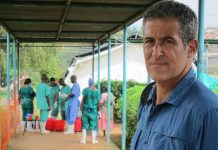
Airborne transmission of coronavirus is possible in restaurants, gyms, and other closed spaces, according to the World Health Organization (WHO).
The WHO affirmed that the virus could be airborne in certain environments, such as during “medical procedures that generate aerosols.”
The new guidance mentions some research about the spread of the virus through particles in the air in “indoor crowded spaces.” These are “choir practice, in restaurants or in fitness classes” as possible sites of airborne transmission.
“In these events, short-range aerosol transmission, particularly in specific indoor locations, such as crowded and inadequately ventilated spaces over a prolonged period of time with infected persons cannot be ruled out,” the United Nations health agency’s new guidance said.
According to WHO, while early evidence corroborates airborne transmission in such areas, spread by droplets and surfaces could be the cause of transmission in those cases.
“However, the detailed investigations of these clusters suggest that droplet and fomite transmission could also explain human-to-human transmission within these clusters,” the guidance said.
Further research needed
The WHO recommends further research to analyze preliminary findings. The agency noted that the main mode of transmission could still be through respiratory droplets.
Airborne transmission of the coronavirus could happen if virus-carrying droplets “generate microscopic aerosols” by evaporating. Moreover, the airborne transmission may happen if “normal breathing and talking results in exhaled aerosols.”
The WHO noted that people could inhale the aerosols and become sick. However, the WHO says it remains uncertain if such aerosols would carry enough viable virus to spread infection.
“To date, transmission of SARS-CoV-2 by this type of aerosol route has not been demonstrated; much more research is needed given the possible implications of such route of transmission,” WHO’s guidance said.
Moreover, the WHO noted that it is further exploring the role of different modes of spread, such as by air. The agency wants to find out how much virus can potentially infect people and the types of of environments that post greater risk for spread.
A call from scientists
The new WHO guidance comes after 239 scientists from 32 different countries released an open letter earlier this week asking for WHO and other health officials to acknowledge the new findings on the transmission of the coronavirus.
In an article entitled “It is Time to Address Airborne Transmission of COVID-19,” the scientists emphasize that the WHO needs to seriously look into the role of the airborne spread of Covid-19.
“The body of evidence continues to grow and we adapt,” Dr. Soumya Swaminathan, the WHO’s chief scientist, said Tuesday. “We take this very seriously. We are of course focused on public health guidance.”
Some scientists criticized the slow response of WHO in releasing guidance on the latest research into the coronavirus, which started in Wuhan, China. The WHO defended its guidance, explaining its transparency about its evaluation process and application of healthy skepticism to research that has not been peer-reviewed.






